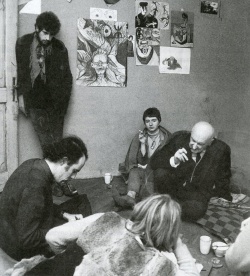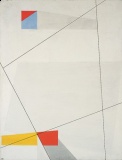Henryk Stażewski
 Henryk Stażewski with Anthony Dubovski and Anka Ptaszkowska at a hippie commune in Ożarów, 1969. | |
| Web | CEAD, Culture.pl, Artyzm, Wikipedia PL |
|---|---|
| Collections | MS Łódź 136, MN Warsaw 25, Zachęta 13, MoMA Warsaw 12, Pompidou 11, MOCA 3, Starak Warsaw 2, MN Wrocław 1+, Tate 1, MoMA 1, Brooklyn M, MCA Chicago 1, Ludwig M Budapest |
Henryk Stażewski was a Polish avant-garde painter and designer. Stażewski was a representative of the Constructivist movement, as well as the co-creator of the Geometric Abstract art movement, and a member of the Cercle et Carré group of abstract painters based in Paris.
Contents
Life and work[edit]
This section is sourced from Irena Kossowska's article on Stażewski (2001) published on the Culture.pl portal.
Born 1894 in Warsaw. 1913-19 studied under Stanislaw Lentz at Warsaw's Szkoła Sztuk Pieknych [School of Fine Arts]. Joined the first-ever Polish avant-garde group created in 1917, initially referred to as the Polish Expressionists and renamed itself the Formists in 1919. 1920 debuted with his works with the Formists at the Towarzystwo Zachety Sztuk Pieknych [Society for the Encouragement of the Fine Arts] in Warsaw. 1921 presented his paintings along with Mieczyslaw Szczuka at the Polish Artistic Club. 1922 participated in the Formists' F 9 exhibition at the Salon of Czesław Garliński in Warsaw. 1923 participated in The New Art Exhibition in Vilnius and the International Exhibition of New Art in Lodz; these two events effectively initiated the Constructivist movement in Poland. Founding member of the Blok group (1924-1926) and other groups which built on their program, including Praesens (1926-29) and a.r. (1929-1936). Also participated in editing the magazines 'Blok' and 'Praesens'.
1923 he turned towards designing interiors and stage scenery and presented his avant-garde works at the Lauren-Clement Automobile Showroom in Warsaw. Early 1924 Stażewski traveled frequently to Paris, where he developed close relationships with Mondrian and Michel Seuphor. Published a number of theoretical writings and essays. Joined the Paris-based international groups Cercle et Carré (from 1929) and Abstraction-Création (from 1931). Since 1926 he represented Polish art abroad in exhibitions organized by the Towarzystwo Szerzenia Sztuki Polskiej wsrod Obcych [Society for the Propagation of Polish Art Among Foreigners]. 1928 he designed the covers of MUBA magazine, produced in Paris by the Lithuanian poet Juozas Tysliava; also, as an extension of his Parisian activities, in 1929 he began working with Jan Brzękowski and Wanda Chodasiewicz-Grabowska in publishing the magazine L'Art Contemporain - Sztuka Współczesna. Participated in numerous international exhibitions, including the 1st International Exhibition of Modern Architecture (Warsaw, 1926), the Exhibition of Theatrical Art (Paris, 1926), the Machine Age Exposition (New York, 1927), and the Konstruktivisten Exhibition (Basel, 1937). Stażewski was among the artists whose works were incorporated in the International Collection of Modern Art made available to the public at the Museum of Art in Lodz in 1931. 1932 exhibited his work with the group Nowa Generacja (New Generation) at Lvov's Towarzystwo Przyjaciół Sztuk Pięknych [Friends of Fine Arts Society] and the Lodz branch of the Instytut Propagandy Sztuki [Institute of Art Propaganda], while in 1935 he presented his works at the exhibition of the Krakow Group in Krakow. 1933 co-founded the Kolo Artystow Grafikow Reklamowych [Circle of Graphic Artists in Advertising], his credits at the time including numerous typographic designs, most of which were Neoplasticist in style. 1933 his first solo exhibition of was organized alongside a presentation of the works of Karol Kryński at the Instytut Propagandy Sztuki [Institute for Art Propaganda] in Warsaw. Almost all of the artworks Stażewski produced before 1939 were destroyed during World War II.
After the war the artist joined the Klub Mlodych Artystow i Naukowcow [Young Artists' and Scientists' Club] and collaborated with the avant-garde Galeria Krzywe Koło [Crooked circle Gallery] in Warsaw. 1965 joined with Wiesław Borowski, Anka Ptaszkowska, and Mariusz Tchorek in creating the Foksal Gallery. Stażewski's first post-war solo exhibition was held in 1955 at Warsaw's Klub Zwiazku Literatow [Association of Writers Club]. Presented his works at numerous exhibitions of Polish contemporary art abroad, including shows in Paris (Musée d'Art Moderne, 1977, 1982; Centre Georges Pompidou, 1983), Stockholm, Amsterdam, Brussels, and Geneva (1959), Venice (1959, 1966, 1986), New York (Museum of Modern Art, 1976), Oslo (1961), Essen (1962, 1973), Stuttgart (1962), Chicago (1964, 1966, 1967, 1972), Bochum (1964), Tel-Aviv (1965), Tokyo (1966), London (Royal Academy, 1970; 1984), Strasburg (1970), Düsseldorf (1974, 1981, 1982), Milan (1974, 1986), Zurich (1974, 1975), Hamburg (1975), Madrid, Berlin, and Cologne (1977), Rome (1979), and Los Angeles (1981). A retrospective of Stażewski's works was organized in 1994 at the Museum of Art in Lodz. Received an honorable mention at the 33rd Biennale of Art in Venice in 1966, and in 1972 he was awarded the Gottfried von Herder Prize by the University of Vienna. Died 1988 in Warsaw.
Stażewski's membership in the avant-garde was apparent in his first drawings, which referenced Cubism in their structure, and in his decoratively over-stylized portraits and still lifes dating from 1917-23. The works of his Constructivist phase were clearly inspired by the theory of Unism propagated by Władysław Strzemiński, reflected in his textural differentiation of planes on what were otherwise largely monochromatic canvases. The influence of Strzemiński's architectural compositions is apparent in Stażewski's paintings analyzing the relationships figures to their background, and particularly in a series of works in which letters are incorporated into the geometric rhythms of the compositions' structures. Strong links between Stażewski's art and the Neoplasticism of the De Stijl group are evident in the artist's consistent construction of paintings on a grid of horizontal and vertical lines, as well as in his use of the three primary colors - red, yellow, and blue - and the three "non-colors" - black, white, and gray (Composition [Kompozycja], 1930). The artist modified these rudimentary structures somewhat by linking distinct color planes through their rounded "corners". Stażewski's abstract paintings of the 1930s and 1950s were free of such structural rigor. In these works biomorphically or geometrically shaped planes of pure color are independent of any of the dynamic lines that traverse the plane. In the early 1930s a figurative vein appeared in the artist's work, one that he would later build on throughout the 1950s. In the decade preceding the war, however, Stażewski produced an abundance of landscapes, portraits, and still lifes. His compositions from the late 1940s and early 1950s lie on the border between figurative art and abstraction. These allude either to still lifes or, in the energy of their wave-like contours, to the wartime drawings of Strzemiński. The works are evidence of the artist's independence from the "normative aesthetics" of Socialist Realism. Though characterized by a high degree of formal differentiation, the artist's works of the 1960s and 1970s were all very much within the frame of geometric abstraction.
In the second half of the 1950s Stażewski supplemented his visual language with a new element - the relief. This form would supplant pure painterly media in his art for the next twenty years. Initially his reliefs had a very loose structure and were built of colorful, rough-textured elements that referenced organic forms (Relief, c. 1955). His reliefs of the 1960s were characterized by elements covered in "half-tone screens" that energized their surface by creating the illusion of vibration. The works of the early part of this decade also manifest the artist's fascination for white, which was a manifestation of his reflections on the neutrality of form "in and of itself" and on its dependence on compositional context. Stażewski's exploration of the infinite potential configurations of a series of moveable, barrel-like elements was a manifestation of his confrontation of the concepts of "order" and "coincidence", and fundamentally consisted of creating situations that were possible but had not yet come to fruition (Grey and White Relief no. 9 [Relief szary i bialy 9], 1964). During his "white period", Stażewski also attempted to penetrate space in a series of copper reliefs dating from the years 1964-67. Their multi-dimensional nature was the result of thickened and overlaid forms and light reflections that were multiplied on the polished metal surfaces (Copper Relief 9 [Relief miedziany 9], 1965). The reliefs Stażewski painted in the 1970s were made dynamic through unexpected disturbances of their geometric structure and unpredictable negations of the principles of regular compositional rhythm (Relief 2, 1972). In the same period Stażewski reverted to the formula of "white paintings", which stimulated the artist to reflect on the relationship between art, science, and metaphysics, and constituted a continuation of his investigations into the order-chaos dichotomy.
In 1975 Stażewski created a series of works that analyzed the composition of George de la Tour's paintings and embodied the artist's conviction that geometry is the link between the art of all epochs. This hypothesis on the universalistic nature of geometry was expressed once again in a series of paintings initiated in 1976 titled Reductions [Redukcje]. In these works, abstract space represented by the uniform white plane of the canvas paradoxically plays a very active role and is penetrated in various directions by groups of lines, disintegrating lines, lines running parallel to each other or cutting across the place diagonally. This radical limitation of his visual language and its subordination to an ascetic discipline expressed the feelings of a man confronted with infinity, but endlessly trustful of the "moderation" encoded in the human eye and mind and of the ordering power of geometry. This tendency to subordinate art to the objective laws of science was strengthened in 1968. The colored square is the basic component in the artist's works of this period. Stażewski multiplied it, only slightly differentiating its color, and thus obtained multiple dimensions and intensified chromatic effects. The artist designed these compositions to tame the metaphysical concept of the square.
In 1970 Stażewski once again expanded the scope of his expressive means and enriched his concept of artistic universalism in a work for the 1970 Wroclaw Symposium titled 9 Rays of Light in the Sky [9 promieni swiatla na niebie], created with the help of beams of light generated by reflectors. In his acrylic paintings of the 1970s, color finally became fully expressive, conquering the restrictive shape of squares, distorting the regularity of their configuration, or attacking them with aggressive "rays" (Color Rays [Promienie barw], 1980). In the 1980s, colors combined in vibrant play between geometric elements. Intensive, uniform, often glistening planes of color also appeared on slippers and necklaces painted by Stażewski, an activity he treated jokingly. In addition to painting canvases, the artist also created murals, produced graphic and typographic schemes, and designed interiors, stage scenery, posters and ceramics. Beginning around 1974 he began recording his views about art and philosophy in aphoristic texts. In 1980 Stażewski initiated a program of exchanges of artwork between Polish and American artists to celebrate the 50th anniversary of the creation of the International Collection of Modern Art in Lodz.
Works[edit]
Literature[edit]
- Irena Kossowska, "Henryk Stażewski", Culture.pl, 2001. (English)
- Marta Zboralska, "Living Color: Henryk Stażewski’s Interior Models", Art Journal 80:3, Sep 2021, pp 38-55. [1] (English)
See also[edit]
Links[edit]
- Henryk Stażewski. Late Style, exhibition, Muzeum Sztuki, Łódź, 2023. Curated by David Crowley. Exh. booklet. Exh. review: Handberg (ARTMargins).



